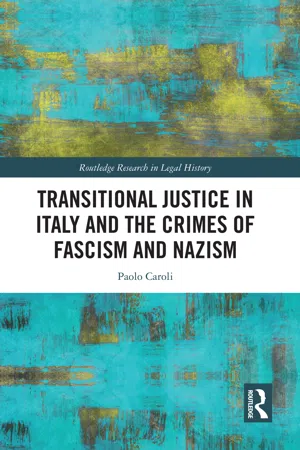
Transitional Justice in Italy and the Crimes of Fascism and Nazism
Paolo Caroli
- 336 pagine
- English
- ePUB (disponibile sull'app)
- Disponibile su iOS e Android
Transitional Justice in Italy and the Crimes of Fascism and Nazism
Paolo Caroli
Informazioni sul libro
This book presents a comprehensive analysis of the Italian experience of transitional justice examining how the crimes of Fascism and World War II have been dealt with from a comparative perspective.
Applying an interdisciplinary and comparative methodology, the book offers a detailed reconstruction of the prosecution of the crimes of Fascism and the Italian Social Republic as well as crimes committed by Nazi soldiers against Italian civilians and those of the Italian army against foreign populations. It also explores the legal qualification and prosecution of the actions of the Resistance. Particular focus is given to the Togliatti amnesty, the major turning point, through comparisons to the wider European post-WWII transitional scenario and other relevant transitional amnesties, allowing consideration of the intense debate on the legitimacy of amnesties under international law. The book evaluates the Italian experience and provides an ideal framework to assess the complexity of the interdependencies between time, historical memory and the use of criminal law.
In a historical moment marked by the resurgence of racism, neo-Fascism, falsifications of the past, as well as the desire to amend the faults of the past, the Italian unfinished experience of dealing with the Fascist era can help move the discussion forward. The book will be an essential reading for students, researchers and academics in International Criminal Law, Transitional Justice, History, Memory Studies and Political Science.
Domande frequenti
Informazioni
Part I
The Italian experience of transitional justice
1 Historical, legal and judicial context of the transition
1.1 What do we call transitional justice?
the full range of processes and mechanisms associated with a society’s attempts to come to terms with a legacy of large-scale past abuses, in order to ensure accountability, serve justice and achieve reconciliation. These may include both judicial and non-judicial mechanisms, with differing levels of international involvement (or none at all) and individual prosecutions, reparations, truth-seeking, institutional reform, vetting and dismissals, or a combination thereof.1111 Cf. UN, Secretary-General, The Rule of Law and Transitional Justice in Conflict and Post-Conflict Societies. Report of the Secretary General, UNSCOR, UN Doc S/2004/616, 23 August 2004, updated in 2011.
Anything that a society devises to deal with a legacy of conflict and/or widespread human rights violations, from changes in criminal codes to those in high school textbooks, from creation of memorials, museums and...
Indice dei contenuti
- Cover
- Half-Title
- Series
- Title
- Copyright
- Dedication
- Contents
- Timeline of the main historical events
- Timeline of the main transitional justice events
- Acknowledgements
- Introduction
- PART I The Italian experience of transitional justice
- PART II A critical approach to the transition
- PART III Facing the present, facing the future
- Index